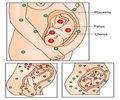Cocaine use during pregnancy can cause subtle but disabling cognitive impairments -- attention deficits, learning disabilities and emotional problems
Cocaine use during pregnancy can cause subtle but disabling cognitive impairments -- attention deficits, learning disabilities and emotional problems – Says a recent study by investigators.
The studty Investigators at the Vanderbilt Kennedy Center for Research on Human Development may help explain the long-term behavioral and neurological problems associated with prenatal exposure to cocaine. In a recent issue of the Journal of Neuroscience, Gregg Stanwood, Ph.D., and Pat Levitt, Ph.D., report that prenatal cocaine exposure in rabbits causes a long lasting displacement of dopamine receptors in certain brain cells, which alters their ability to function normally.Though this effect has not yet been assessed in cocaine-exposed children, the findings give researchers a place to start looking.
'The hysteria surrounding the 'crack baby' was sort of overblown,' said Stanwood, research assistant professor of Pharmacology and lead author on the study.
Incredibly high levels of cocaine -- usually coupled with the abuse of other drugs -- can lead to premature labor, preterm birth and low birth weight, Stanwood said.
'But in women who have abused relatively low recreational doses of cocaine, it is actually very hard to distinguish those children at birth from children born to anyone else,' he said. 'However, as those children age, they do develop deficits in their cognitive and emotional development.'
These children often exhibit attention and arousal problems, similar to children with attention deficit hyperactivity disorder (ADHD). However, the standard treatments for ADHD -- Ritalin and other stimulants -- are not always effective in these children.
Advertisement
'We thought that it was important to set up an animal model that recapitulates a key feature of human abuse, that being intravenous exposure to low doses of cocaine,' Stanwood said.
Advertisement
Additionally, these cocaine-exposed offspring showed attention problems as well as insensitivity to stimulants like amphetamine, suggesting that cocaine exposure had altered the development of the dopamine pathways in the brain.
'In collaboration with Dr. Eitan Friedman of the City University of New York, we had previously shown a decrease in signaling of a particular receptor protein, the dopamine D1 receptor," Stanwood said. "We know that this receptor is involved in regulating the formation of cortical circuitry. It's also involved in the behavioral effects of amphetamines and cocaine.'
'The current study was an attempt to look at the mechanism of this decrease in D1 receptor signaling,' he said.
Stanwood examined the levels of D1 receptor in brain cells taken from 'teenage' rabbits that were exposed to cocaine during that short, sensitive prenatal period.
He found that cocaine exposure did not alter the total amount of D1 receptor produced in the brain. However, there was a dramatic alteration in the location of the protein within the cell.
'It's not where it should be,' he said. D1 receptors are normally found at the cell surface, but neurons from the cocaine-exposed animals showed the receptor was predominantly sequestered inside the cells.
'The fascinating thing is that this effect appears permanent,' said Stanwood. This implies that cocaine exposure during a brief, sensitive period of neural development can lead to long-lasting effects at the cellular level.
This change also altered the growth of neuronal processes, suggesting that the altered D1 receptor trafficking may underlie the changes in neuronal architecture and behavior that Stanwood and others have previously observed.
What remains to be determined, he cautioned, is whether D1 receptor localization is affected in humans exposed to cocaine prenatally.
If found in humans, 'it gives us a new way to think about helping those children as they continue to mature.' Because cocaine exposure seems to alter the distribution of the D1 receptor, Stanwood suggests that researchers might find a way to 'steer' the receptor into the correct cellular location. That could provide new avenues for treating the attention problems in cocaine-exposed children, as well as in children with stimulant-resistant ADHD.
'Neither we nor anyone else has yet identified whether this mechanism occurs in the human population,' Stanwood said, 'so that is a critical next step.'
Source-Eurekalert
SRI











